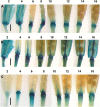The manipulation of auxin in the abscission zone cells of Arabidopsis flowers reveals that indoleacetic acid signaling is a prerequisite for organ shedding
- PMID: 23509178
- PMCID: PMC3641234
- DOI: 10.1104/pp.113.216234
The manipulation of auxin in the abscission zone cells of Arabidopsis flowers reveals that indoleacetic acid signaling is a prerequisite for organ shedding
Abstract
A number of novel strategies were employed to examine the role of indoleacetic acid (IAA) in regulating floral organ abscission in Arabidopsis (Arabidopsis thaliana). Analysis of auxin influx facilitator expression in β-glucuronidase reporter plants revealed that AUXIN RESISTANT1, LIKE AUX1, and LAX3 were specifically up-regulated at the site of floral organ shedding. Flowers from mutants where individual family members were down-regulated exhibited a reduction in the force necessary to bring about petal separation; however, the effect was not additive in double or quadruple mutants. Using the promoter of a polygalacturonase (At2g41850), active primarily in cells undergoing separation, to drive expression of the bacterial genes iaaL and iaaM, we have shown that it is possible to manipulate auxin activity specifically within the floral organ abscission zone (AZ). Analysis of petal breakstrength reveals that if IAA AZ levels are reduced, shedding takes place prematurely, while if they are enhanced, organ loss is delayed. The At2g41850 promoter was also used to transactivate the gain-of-function AXR3-1 gene in order to disrupt auxin signaling specifically within the floral organ AZ cells. Flowers from transactivated lines failed to shed their sepals, petals, and anthers during pod expansion and maturity, and these organs frequently remained attached to the plant even after silique desiccation and dehiscence had taken place. These observations support a key role for IAA in the regulation of abscission in planta and reveal, to our knowledge for the first time, a requirement for a functional IAA signaling pathway in AZ cells for organ shedding to take place.
Figures







References
-
- Abebie B, Lers A, Philosoph-Hadas S, Goren R, Riov J, Meir S. (2008) Differential effects of NAA and 2,4-D in reducing floret abscission in cestrum (Cestrum elegans Schlecht) cut flowers are associated with their differential activation of Aux/IAA homologous genes. Ann Bot (Lond) 101: 249–259 - PMC - PubMed
-
- Aloni R, Aloni E, Langhans M, Ullrich CI. (2006) Role of auxin in regulating Arabidopsis flower development. Planta 223: 315–328 - PubMed
-
- Blakeslee JJ, Peer WA, Murphy AS. (2005) Auxin transport. Curr Opin Plant Biol 8: 494–500 - PubMed
Publication types
MeSH terms
Substances
Grants and funding
LinkOut - more resources
Full Text Sources
Other Literature Sources
Molecular Biology Databases

